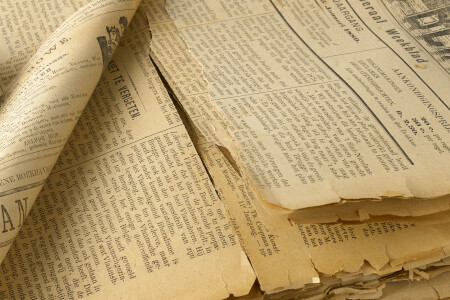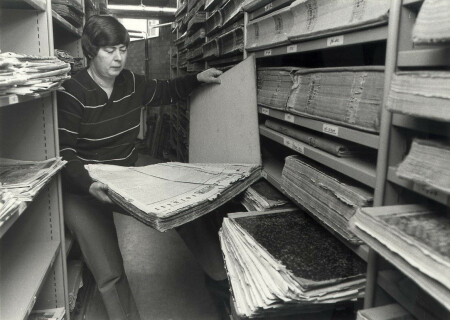New Tidings rescues historic newspapers from decay
Since 2021, together with Flanders Heritage Library, we’ve been working on the three-year project: New Tidings. National programme for preserving Flemish newspaper heritage. This project is working towards a mass digitisation programme of historical newspapers in Flemish heritage collections that are at risk of becoming lost. We’re collaborating with 45 heritage preservation organisations for this, and together outlining the route to a large-scale rescue operation.
Flanders has a wealth of archive collections that must not be lost. We’re aiming to safeguard this heritage for the future through the use of digitisation and then sustainable preservation and management. We’ve worked with Flanders Heritage Library in the past on the News of the Great War and Abraham 2020 projects.
Challenge
Digitising our newspaper heritage is crucial. No matter how carefully you store a newspaper collection, paper degradation is an unavoidable and irreversible process that will eventually overcome every single sheet. Newspapers are a rich source of history, but many will simply acidify and fall apart over time. Digitisation is therefore the only way to rescue the contents of this valuable heritage.

© Vlaamse Erfgoedbibliotheken / Metamorfoze - Photo: Yvo Wennekes
Our role
New Tidings stems from the project Abraham 2020: New life for old news (link in Dutch), which further developed Abraham, the catalogue of Belgian newspapers. A catalogue of Flemish newspaper heritage is after all essential for starting a mass digitisation project. Together with Flanders Heritage Library, we therefore investigated the feasibility of a coordinated approach for digitising this Flemish newspaper heritage, with New Tidings as the first outcome, to serve as the preliminary process.
As the main partner for New Tidings, meemoo is jointly responsible for the overall project management. We’re also taking care of the intake and sustainable preservation of our content partners’ digitised newspapers, which are stored in our meemoo archive system. We will ultimately make it possible to consult these digitised Flemish newspapers from diverse collection managers on our retrieval platform, hetarchief.be (link in Dutch).
Approach
We’re working on four different aspects over the space of three years: a digitisation programme, optimising existing content, a high-performing interface, and expertise-sharing. At the end of the project, we want to arrive at a five-year plan for large-scale digitisation. We will be able to get started with this upon completion of the New Tidings project as soon as the necessary funding becomes available.
First phase - 2021
In the first year of the process, we focused on developing a practical blueprint for the national programme.
Planning the digitisation programme
To gain a clear picture of the scope and number of newspapers involved, we drew up a selection list. This will serve as the basis for the large-scale digitisation and help us to estimate how much time and money we’ll need for the rescue programme, as well as helping us to decide which collaborations we should enter into. Flanders Heritage Library has developed the online selection tool Courant to help collection managers with this selection.
Optimising existing content
We’re also exploring new techniques to improve the searchability of newspapers that have already been digitised, for example by using Optical Character Recognition (OCR) to convert scans into machine-readable text. We tested the OCR quality of a representative sample in this phase, and discovered that there is room for improvement in the OCR texts that are currently available (link in Dutch).
Interface and copyright aspects
We’re aiming to publish the digitised newspapers online in a re-usable format so that they can be consulted, and therefore investigated what the interface for this digital newspaper archive needs to look like. In addition, we’ve carried out an initial analysis of copyright options to also include more recent newspapers (still subject to copyright) on hetarchief.be (link in Dutch), a user environment that is planned to launch in 2024.
Second phase - 2022
Digitisation programme
We gathered together specific information in Courant in this phase, with collection managers making a start with selecting the titles, taking three basic criteria into account:
the publication must have the characteristics of a newspaper;
the newspaper must be published within the current borders of Flanders or for a Flemish target audience elsewhere;
the newspaper must not yet be digitised.
In the autumn of 2022, more than 30 institutions had already supplied their information – equivalent to over 3.7 million pages ready for (urgent) digitisation.
Infrastructure development
The functional requirements for the interface were already clear in the first phase, and users will be able to use it to consult the digitised newspapers. In the second phase, we then investigated options for integrating digitised newspapers with other online (newspaper) platforms in The Archive, and drew up an action plan.
Third phase - 2023
Digitisation programme
In the final year of the project, we’re implementing a working process for mass digitisation on a small scale, and starting on the digitisation of a pilot batch (link in Dutch) in line with the GIVE newspaper project, Primeur. It involves about 65,000 newspaper pages from 8 partners put under the scanner at Dutch company Picturae. The pilot organisations –Tielt Municipal Archive, Stedelijk Museum Hoogstraten, the Bakery Museum in Veurne and partners from Waasland Heritage Society (Beveren municipal archive, Temse municipal archive, the local history circle d'Euzie, Lokeren city archive and Sint-Niklaas Public Library) – are very diverse in scope and character, so we can be certain that both smaller and regional collections are represented in this national programme.
Upon completion of the New Tidings project, the rescue programme can then progress at full speed as soon as the necessary funding becomes available.
Optimising existing content
In the third phase, we’re carrying out a pilot project to optimise the OCR on 50-100k newspaper pages. This will allow us to implement the chosen method, test the workflow feasibility, and tighten up the financial picture for subsequent large-scale digitisation.
We will be incorporating our content partners’ digitised newspapers and storing them sustainably in the meemoo archive system. This is a challenge because not all digital newspaper collections satisfy the standards required for our archive system. We are looking for a solution for this. The digitised newspapers will then be made accessible via hetarchief.be (link in Dutch) user platform from 2024.
Interface
We’re also starting to develop the newspaper interface for hetarchief.be (link in Dutch) in this phase, which is scheduled to launch 2024.
Partners
Flanders Heritage Library (coordinator)
meemoo (main partner)
45 partner organisations:
Staatsbibliothek zu Berlin / Stiftung Preußischer Kulturbesitz, Metamorfoze, Histories vzw, Ghent Centre for Digital Humanities (History Department, Ghent University), KBR - Royal Library of Belgium, Hendrik Conscience Heritage Library, University of Antwerp Library, Bruges Public Library (Openbare Bibliotheek Brugge), Hasselt Limburg Library (Bibliotheek Hasselt Limburg), KU Leuven Libraries - Special Collections, Ghent University Library - Book Tower, Archiepiscopal Archive in Mechelen (Aartsbisschoppelijk Archief te Mechelen), ADVN - Archive for National Movements, Amsab-Instituut for Social History, AMVB - Archive and Museum for the Flemish Living in Brussels, Archives of the Collegiate Church of Our Lady in Aarschot (Archief van de Collegiale O.-L.-Vrouwekerk Aarschot), Ascania Royal Historical Society (Koninklijke Heemkring Ascania vzw), den AST Museum in Halle, DIVA (Museum for Diamonds, Jewellery and Silver), Triverius Brakel Documentation Centre, KADOC Documentation and Research Centre on Religion Culture and Society from KU Leuven, Koksijde Local Government, Liberas, Memorial Museum Passchendaele 1917, Museum of Deinze and the Leie Region, In Flanders Fields Museum and Yper Museum (Musea Stad Ieper), Municipality of Opwijk - The Opwijk Archives (‘t Opwijks Archief), Ostend Public Library, Aalst Municipal Archive, Bruges Municipal and OCMW Archive (Stads- en OCMW-archief Brugge), Diest Municipal Archive, Kortrijk Municipal Archive, Leuven Municipal Archive, Lokeren Municipal Archive, Tongeren Municipal Archive, Tielt Municipal Archive, Hoogstraten Municipal Museum, Denderland Heritage Body (Erfgoedcel), k.ERF Heritage Service, Land van Dendermonde Heritage Body, Leie Schelde Heritage Body, Interwaas / Waasland Heritage Body, zuidwest Heritage, Cultuurregio Pajottenland & Zennevallei, CO7

